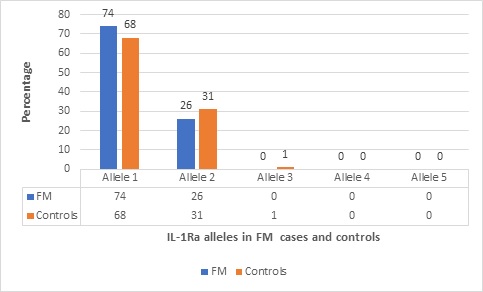Session Information
Date: Saturday, November 6, 2021
Title: Fibromyalgia & Other Clinical Pain Syndromes Poster (0118–0127)
Session Type: Poster Session A
Session Time: 8:30AM-10:30AM
Background/Purpose: Interleukin-1 receptor antagonist (IL-1Ra) variable number of tandem repeats (VNTR) polymorphism is a known to influence the production of IL-1Ra and has been considered as a susceptibility marker for various autoimmune diseases.1 Serum IL-1Ra levels were found to be low in fibromyalgia (FM) patients in our previous study.2 Here, we have studied the role of IL-1Ra VNTR polymorphism in influencing disease susceptibility in FM.
Methods: This case-control study was performed at a tertiary care centre in South India from March 2020 to March 2021. FM patients diagnosed as per 2016 modified ACR 2010/2011 criteria and age, gender, and BMI matched healthy controls were included in the study. FM patients with other co-existing rheumatological disease or psychiatric illness were excluded. Genomic DNA was isolated from the peripheral blood of all the enrolled participants and was subjected to polymerase chain reaction to study the frequency of alleles and genotypes of the IL-1Ra gene (IL-1RN) in FM cases and controls. Chi-square and Fisher’s exact test were applied to test statistical significance.
Results: A total 79 participants (35 FM cases and 44 matched controls, all females) were enrolled; of the 5 known alleles of IL-1Ra only 3 alleles and out of 8 known genotypes of IL-1Ra only 4 genotypes were detected in our study population. IL-1Ra allele 1 frequency in FM patients was 52 (74%) and 60 (68%) in controls; IL-1Ra allele 2 frequency in FM patients was 18 (36%) and 27 (31%) in controls; IL-1Ra allele 3 was present in only one control; these differences were not significant statistically (p = 0.512) (Figure-1).
IL-1Ra genotype1/1 was present in 19 (54%) FM patients and 20 (45%) controls, genotype 1/2 was present in 14 (40%) FM patients and 20 (45%) controls, genotype 2/2 was present in 2 (6%) of FM patients and 3 (7%) controls, and genotype 2/3 was noted only in one participant of the control group; these differences were not significant statistically (p = 0.753) (Figure-2).
On comparison of baseline characteristics of FM patients with IL-1Ra genotype 1/2 had higher mean BMI- (28.0, SD-3.8 kg/m2) compared IL-1Ra genotype 1/1 FM patients mean BMI (24.52, SD- 2.75 kg/m2) and this difference was statistically significant (p = 0.012).There was no association of baseline disease severity of FM (assessed by wide spread pain index, symptom severity score, revised fibromyalgia impact questionnaire, brief pain inventory pain and function score) with IL-1Ra genotype and allelic frequency (p > 0.05) (Figure-3).
Conclusion: IL-1Ra VNTR polymorphism was not a susceptibility marker for FM in our study population and it did not show any association with FM disease severity parameters. Obesity in FM patients was associated with IL-1Ra genotype 1/2.
References:
1. Rafiq S, Stevens K, Hurst AJ, Murray A, Henley W, Weedon MN, et al. Common genetic variation in the gene encoding interleukin-1-receptor antagonist (IL-1RA) is associated with altered circulating IL-1RA levels. Genes and Immunity. 2007 Jun;8(4):344–51.
2. Surendran S, Mithun CB, P199 Serum cytokines profile in fibromyalgia syndrome and its correlation with disease outcome measures. Rheumatology,2020 April20;59(2).
To cite this abstract in AMA style:
Tiwari A, CB M, Biswas L, Surendran S, Marwaha V, Chickermane P, Shahul A. Interleukin 1 Receptor Antagonist (IL-1Ra) Variable Number of Tandem Repeat (VNTR) Polymorphism in Fibromyalgia Patients in South India [abstract]. Arthritis Rheumatol. 2021; 73 (suppl 9). https://acrabstracts.org/abstract/interleukin-1-receptor-antagonist-il-1ra-variable-number-of-tandem-repeat-vntr-polymorphism-in-fibromyalgia-patients-in-south-india/. Accessed .« Back to ACR Convergence 2021
ACR Meeting Abstracts - https://acrabstracts.org/abstract/interleukin-1-receptor-antagonist-il-1ra-variable-number-of-tandem-repeat-vntr-polymorphism-in-fibromyalgia-patients-in-south-india/



